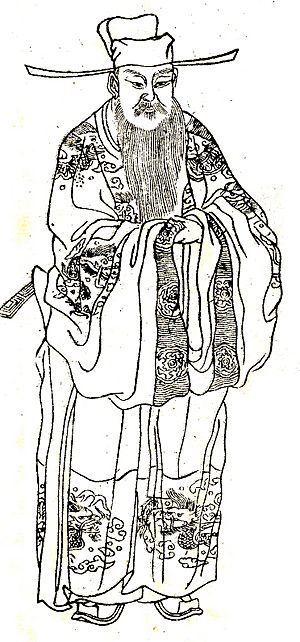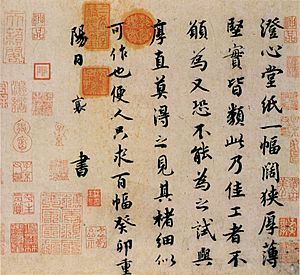Cai Xiang facts for kids
Cai Xiang (born 1012, died 1067) was a very talented person from China's Song dynasty. He was a famous calligrapher, which means he wrote beautifully. He also worked in government, designed buildings, and wrote poems. Many people thought he was the best calligrapher of his time.
Contents
Cai Xiang's Life Story
Cai Xiang was born in 1012 in a place called Xianyou county. This area is now part of Putian in Fujian province, China.
When he was 18, in the year 1030, he passed a very difficult test. This test was called the jinshi exam. Passing it meant you were an "advanced scholar" and could get important government jobs.
Cai Xiang held many important roles in the government. One of his highest jobs was helping with official writings for the emperor. He also worked as a transportation officer in Fujian province.
Building the Wan-an Bridge
While working in Fujian, Cai Xiang helped build a very important bridge. This was the Wan-an Bridge in Quanzhou. Building such a large bridge showed his skills as an engineer.
Special Tea Maker
Cai Xiang was also known for making special tea. He created small "Dragon Tribute Tea Cakes." These cakes were so good that people said they were harder to find than gold!
Cai Xiang's special pen name was Junmo. After he passed away, he was given the honorary name Zhonghuei.
What Cai Xiang Created
Cai Xiang was a busy man who left behind many works.
Famous Writings
One of his most famous writings is an essay called "The Record of Tea." It's also known as the "Tea Note." He wrote this between 1049 and 1053. It shares his knowledge about tea.
- Calligraphy: He created beautiful writing on a stone tablet for the Wan'an Bridge.
- Poetry: His poems were collected in a book called "Collected Works of Cai Zhonghuei."
- Letters: He wrote many letters, like the "Letter on Cheng Xin Tang Paper."
Cai Xiang's Thoughts on Tea
Cai Xiang believed that tea had its own natural smell. He once said:
Tea has its own natural smell. But some tea makers like to add a tiny bit of camphor. They think it makes the tea smell better. However, people in Jian'an never mix anything into their tea. They are afraid it will take away the tea's natural smell.



